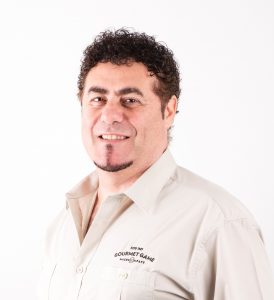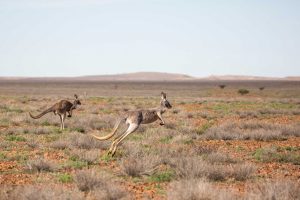The wild game industry has come of age over the last decade with domestic and export demand for the nation’s open range meats growing substantially driven by ‘on-trend’ consumer movements. Reflecting the expansion of its membership, which includes a broad range of wild game meats and skins – kangaroos, wild goats, deer and rabbit among them – the Kangaroo Industry Association of Australia (KIAA) has undergone a rebranding to the Australian Wild Game Industry Council (AWGIC).
By: Stephanie Flynn
Ray Borda has been a leader in the wild game meat industry for over 40 years, sitting as president of the KIAA for a decade, overseeing its transition to the AWGIC and heading up one of the two major industry players, South Australia-based Macro Group Australia, with the other being Queensland-based Game Meat Processing Pty Ltd.

Mr Ray Borda, president, Australian Wild Game Industry Council
Mr Borda spoke with Australian Meat News about the ‘coming of age’ of the wild game industry, the drivers for its growing domestic and export demand and the unique challenges faced by the industry in guaranteeing supply of its open range meats.
According to Mr Borda, the transition from the KIAA which had been in existence for some 30 years to the AWGIC better reflects the fact that today, kangaroo meats only comprise 60 percent of its stock-in-trade with other open range proteins now making up 40 percent.
“When you are a shooter out in the bush you are coming across any of those animals, our shooters are licensed to take them and there is a niche market for all of these meats, as well, farmers have a need for these animals to be removed, so we provide a service,” Mr Borda said.
“There is a domestic demand for all these meats both for human and pet consumption, export demand is also there and both are growing,” he said.
Consumer movements are driving growth…..”
The consumer-driven movements toward sustainability, reducing food waste, and the developing trend among the health-conscious toward consumption of foods which have limited processing interventions, have been the catalysts for the growth in demand for wild game meats.
“Health and welfare are a major focus these days as people are looking more at what they are eating and where it comes from, all of these animals are non-farmed animals and people like the idea, psychologically, that they are free-living animals,” Mr Borda said. “These animals are leaner, they have less fat content, and feed on natural, wild-grown feeds,” he said.
While recent detailed studies into the nutritional composition of kangaroo meat are scant, the Department of Foreign Affairs and Trade (DFAT), officially notes that it is high in energy, protein, iron, zinc, Omega-3 fatty acids and B vitamins.
“The fight against food waste is another big movement, it is about changing industry practices, what we would have done in the past is kill these wild animals during the culling processes and leave them on the ground, that is a big food waste, today we harvest them and utilise the meat either for humans or pets, that is why the wild game meat industry in Australia is on-trend,” Mr Borda said.
These factors make Australia’s kangaroo meat, as well as its wild boar, goats, deer and rabbits, noted globally for their unadulterated wild foraging nature. They are fulfilling a niche but growing market in the food service and food retail sectors around the world, most notably in Japan and Korea as well as the US and in Europe.
There are, according to DFAT, some 60 overseas markets to which Australia’s kangaroo meat exporters have access. Official figures on the value of Australia’s kangaroo meat exports are as scant as those on its nutritional composition, but the Department of Agriculture, Fisheries and Forestry valued exports at $12.8 million in 2019/20.
“Whereas once, Russia was the major market as a cheap meat for their sausage-making, they replaced that demand with buffalo meat and we have since had to decline Russian requests for supply because kangaroo is no longer a meat that can be supplied cheaply, we are far more sophisticated today than in those early days,” Mr Borda said.
“A difficulty we have, is that if the market is down for the major proteins, we are in the same boat, currently the major proteins are not getting the high prices so we have to be market competitive, we cannot be dearer than beef or lamb,” he said.
It has been no easy feat to establish supply infrastructure….
Mr Borda points out that while kangaroo has been sold to the world for some 30 years – beef, lamb and pork have been sold for hundreds of years – it is comparatively a relatively new niche market. It has been no easy feat to establish the infrastructure required to bring Australia’s wild game meats to both domestic and global markets with the industry beset by unique challenges, not faced by the more traditional protein supply channels, at every step of the process from the wild to processing.
“The nature and size of our country means that some of my trucks are travelling 4,000 km to pick up the kangaroos, venison or whatever else and when you have interruptions like severe droughts or floods, it means we have had to establish a broad supply structure to overcome interruptions to supply,” Mr Borda said.

By necessity, supply systems for wild game meats span some 4,000km
“We source from Queensland, New South Wales, Victoria and South Australia, at any one time we can probably get enough supply from two of those areas despite the climate impacts and the thought of climate change making it even more challenging is daunting,” he said.
Transport in this industry is also challenging with the major operators having had to vertically integrate their operations, doing everything from the ground up through the entire supply chain. This includes establishing their own transport fleets as external commercial transport companies will not travel the long distances along dirt and corrugated roads to collect the carcasses from their often-remote locations and each carcass needs to be loaded manually onto the transport. There is also major infrastructure investment by the two major players with chiller boxes and cool rooms needed to be located on-site in the remote locations where the shooters are based.
“It is expensive but if there is to be a future for the sector the major players like ourselves at Macro Group Australia and Game Meat Processing need to make the investments for and support the whole industry,” Mr Borda said. “There are a lot of difficulties but at the same time it is rewarding because we do feel like we are on trend,” he said.
In terms of processing, there are 60 to 70 wild game meat processors in Australia with the majority licensed for pet food.
Science centre for food testing established in South Australia
Macro Group Australia and Game Meat Processing between them account for about 80 percent of the commercial industry for human consumption and are the nation’s only two exporters to global markets. As with other protein industries, the wild game industry has also been the target of extreme activists receiving both death and bomb threats as well as sabotage of its product in chiller boxes but the industry has used these attacks to propel itself ahead of the issue establishing a stringent welfare policy and a food testing science laboratory under the operations of the Macro Group Australia.
“We have a responsibility as far as animal welfare goes, if we find any breaches of our animal welfare code in our chain, there is immediate suspension while an investigation is carried out because we cannot let that happen, it is an important issue for us,” Mr Borda said. “In my company we have 18 scientists work for us including microbiologists, pathologists, food technicians and food scientists, we are very science-based, it is all about food safety,” he said.
Discovering that there was a major demand throughout the food industry for reliable scientific testing, Mr Borda is now building a two-million-dollar purpose-built premises for the South Australian Analytical Laboratory Services, encouraged by the 600 or so clients from a range of food industries for which the scientists now do testing.
